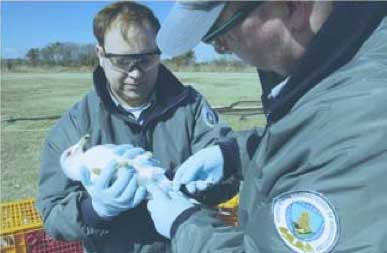
Agricultural News
Government and Industry Offering Response Plans in Case of Bird Flu Fall Outbreak
Tue, 22 Sep 2015 05:10:50 CDT
 Earlier this year, highly pathogenic avian influenza resulted in the depopulation of 7.5 million turkeys, 42.1 million egg-layer and pullet chickens and costs taxpayers $950 million. The U.S. Department of Agriculture as well as industry groups such as the National Chicken Council have compiled a comprehensive response manual to help coordinate and respond against future HPAI infections.
Earlier this year, highly pathogenic avian influenza resulted in the depopulation of 7.5 million turkeys, 42.1 million egg-layer and pullet chickens and costs taxpayers $950 million. The U.S. Department of Agriculture as well as industry groups such as the National Chicken Council have compiled a comprehensive response manual to help coordinate and respond against future HPAI infections.
"APHIS is keenly aware of the significant impact the spring outbreak has had on all parties poultry producers, allied industries, federal and state governments, and the American consumer. As we near the beginning of the fall season, APHIS is confident that its surveillance programs in commercial and wild birds, which are the strongest in the world, will enable us to detect the disease early. If HPAI should reappear in the coming months, APHIS is ready to respond and committed to helping those affected by the disease," APHIS said.
The decline in HPAI detections provided an opportunity to enhance prevention efforts and prepare for additional backyard and commercial poultry cases that may occur in the fall when birds migrate south from their northern breeding grounds, USDA said in its Fall 2015 Preparedness and Response Plan. While HPAI infections since December 2014 have been identified in three of the four U.S. flyways, USDA said it expects HPAI viruses will be brought to the Atlantic flyway by migrating ducks, if they are not already present but as yet undetected in the resident wild duck population.
USDA said it learned many things through this spring's outbreak and have assumed a worst-case scenario beginning in mid-September 2015, with HPAI occurring simultaneously in multiple sectors of the poultry industry throughout the nation. Under this scenario, 500 or more commercial establishments of various sizes could be affected.
The Fall 2015 HPAI Influenza Preparedness and Response Plan organizes information on preparatory activities, policy decisions and updated strategy documents into four key areas:
preventing or reducing future outbreaks;
enhancing preparedness;
improving and streamlining response capabilities; and,
preparing for the potential use of AI vaccines.
The plan published by USDA's APHIS can be reviewed by clicking here.
The Animal and Plant Health Inspection Service report also includes an updated biosecurity self-assessment for the poultry industry; streamlined and updated procedures for providing indemnity and other payments; a draft vaccine use strategy; and additional items of interest to agency's stakeholders.
APHIS said it is publishing an interim rule on HPAI indemnity that will contain a provision requiring all future HPAI-affected commercial poultry producers to self-certify that biosecurity procedures were in place at the time HPAI was detected.
USDA also sent out a survey to all 50 states and five U.S. terrorities questioning plans states have in place to deal with HPAI. USDA concluded from this analysis that the 20 critical worst case scenario states have "all made significant efforts in implementing detection, preparedness and response capabilities for future HPAI cases." Although all have implemented one or more practices to increase biosecurity and address gaps, "there are areas where improvements are needed," USDA said.
USDA also said it has focused considerable effort in the area of depopulation and disposal during its fall planning activities. APHIS developed disposal decision tools to assist responders with selecting the best option(s); these tools include decision guides, checklists and online training modules. APHIS has initiated contract actions to solicit vendors who can provide high-capacity mobile disposal/treatment technologies. In addition, APHIS has studied the demographics of poultry populations, developed mapping coordinates for rendering, landfill, and incineration facilities in the US, and linked these coordinates with a simple automated selection tool.
APHIS also said its goal it to depopulate all affected flocks within 24 hours of preliminary diagnosis. They said if standard methods cannot achieve that goal, the APHIS National Incident Commander will approve on a case-by-case basis the use of ventilation shutdown for depopulation.
The process for calculating and reimbursement of cleaning and disinfection costs has been especially difficult over the course of the 2015 HPAI outbreak, APHIS said. For all future cases, APHIS will pay a standard per-bird rate (separate rates for caged- vs floor-reared operations), based on the cost of the preferred method of dry cleaning and heating, for virus elimination activities. This flat rate can be adjusted based on the time of year to account for the increased cost of heating a facility to the appropriate time and temperature specifications during colder weather.
The National Chicken Council on August 28 released its top biosecurity principles for broiler and broiler-breeder producers to prepare for the potential reemergence of HPAI in the fall.
Click here for the National Chicken Council's recommendations in regards to HPAI.
WebReadyTM Powered by WireReady® NSI
Top Agricultural News
More Headlines...




















